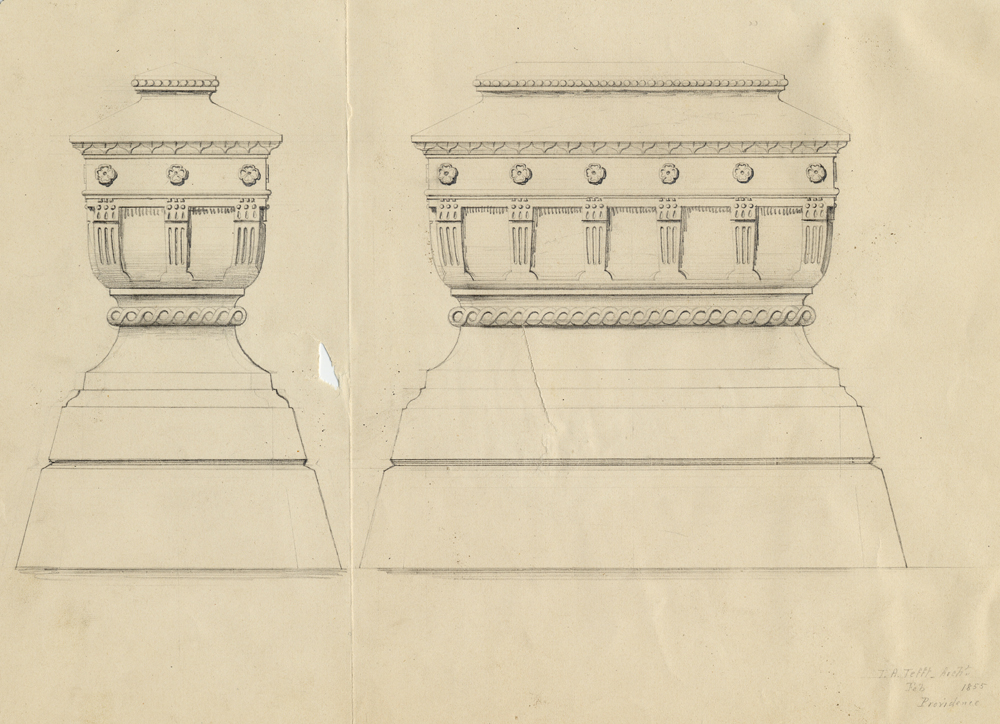I wear a couple of hats here at Brown University, one as staff member of Digital Production Services, aiding in the production of digitized resources for library collections and faculty projects, and another as a MA student in the Center for Public Humanities and Cultural Heritage. Often, these professional and academic roles overlap and intersect. Increasing student and faculty engagement with library collections through use of digitized materials within the Brown Digital Repository is a rewarding aspect of the work we do in Digital Production Services. Quite often, I find myself utilizing the digital resources that I have had a hand in creating in my own scholarly research. For instance, the topic under discussion in my graduate section for AMST1250B: Graves and Burial Grounds this week has been the gravestone designs of Rhode Island architect Thomas Alexander Tefft.
The Thomas Alexander Tefft architectural drawings 1844-1859 are a part of Brown Archival and Manuscript Collections Online, and the nearly four hundred Tefft drawings that constitute the collection are available in the Brown Digital Repository. I knew that Tefft was a native Rhode Islander (born in Richmond in 1826), and a graduate of Brown University (Class of 1851).1 I also knew that Tefft designed many local private residences and public buildings, like Providence’s first Union Station and Rhode Island School of Design’s Memorial Hall. What I didn’t know was that Tefft was also a prolific designer of tombs, monuments and gravestones, many of which can be viewed in Swan Point Cemetery.
Tefft’s signature rundbogenstil (or rounded arch) Romanesque style2 can be seen both in Swan Point’s receiving tomb, which I had the opportunity to view last week as a part of our class’s walking tour of the Cemetery, and in the details of RISD’s Memorial Hall (originally Central Congregational Church) on Benefit Street. The towers of the building, seen in Tefft’s drawing, were damaged in the 1938 hurricane and subsequently removed. While Greek and Gothic revival styles were all the rage in America during the 1830s and ’40s, Tefft favored the revival styles of the Renaissance and the Romanesque. Brown’s collection of Tefft architectural drawings include designs for over 50 gravestones and tombs, in which the range of revival styles can be seen in the Classical, Egyptian, and Romanesque motifs he employed.
Remarkably, Tefft’s substantial body of work was created in just 14 years. In 1859, at the age of 33, the architect died of a fever while in Italy on a Grand Tour.3 Initially, Tefft was buried at Florence’s English Cemetery, but in February of 1860 his body was shipped back to Providence and re-interred in Swan Point Cemetery. Teftt is buried beside James Bucklin, another important figure in Rhode Island architecture, under a gravestone of his own design.4
In 1988, the Department of Art at Brown University collaborated with the National Building Museum on a student-curated exhibit held at Brown’s Bell Gallery. The catalog for the exhibit, Thomas Alexander Tefft: American Architecture in Transition, 1845-1860 is a wonderful resource to consult for more information on Tefft’s short but astonishingly creative career.
- Mitchell, Encyclopedia Brunoniana (Brown University Library, 1993; pp. 536-537). ↩
- Curran, The Romanesque Revival: Religion, Politics, and Transnational Exchange (Penn State Press, 2003; p. 139). ↩
- Curran, The Romanesque Revival: Religion, Politics, and Transnational Exchange (Penn State Press, 2003; p. 139). ↩
- Mitchell, Encyclopedia Brunoniana (Brown University Library, 1993; pp. 536-537). ↩





